La guía más completa de conducción y alquiler de autos en Nueva Zelanda.
Speed Limit and Traffic Signs
In New Zealand, driving is on the left with overtaking on the right. New Zealand has the same system of signs and road code as you would find in the United Kingdom. During winter, especially in the mountains or on South Island, driving can be tricky. Therefore snow chains are highly recommended when renting a car at this season.
 Speed Limit
Speed LimitThere are speed limits of 100 km/h on highways and 50 km/h in urban areas unless signs say otherwise.
 Traffic Signs
Traffic SignsThere are three major types of signs in New Zealand: compulsory, warning and information signs. Here are some of the regulatory signs that you may often see in New Zealand.
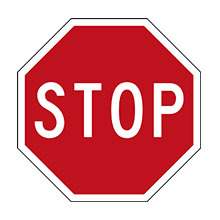 Stop
Stop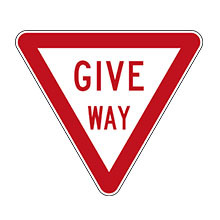 Give Way
Give Way No U-turn
No U-turn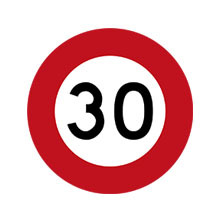 30 km/h Speed Limit
30 km/h Speed Limit No Stopping
No StoppingWarning signs are diamond-shaped with yellow or green background.
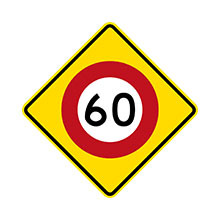 60 km/h Speed Limit Ahead
60 km/h Speed Limit Ahead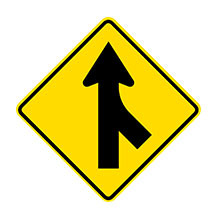 Merging Traffic from Right
Merging Traffic from Right 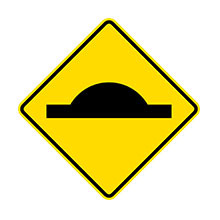 Road Bump
Road Bump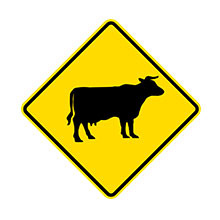 Watch for Large Animals (Cattle)
Watch for Large Animals (Cattle)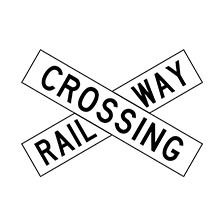 Railway Crossbuck
Railway CrossbuckInformation signs are in rectangular shape with a white background.
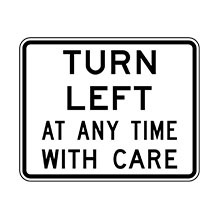 Left Turn at Any Time With Care
Left Turn at Any Time With Care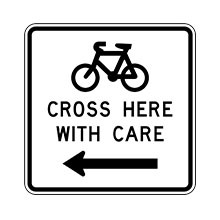 Cyclists Cross Here With Care (to the Left)
Cyclists Cross Here With Care (to the Left)Further information on signs for driving in New Zealand can be found in this booklet.
Seatbelt and Child Safety
 Seatbelt Laws
Seatbelt LawsThe driver is responsible for ensuring all passengers under 15 years wear seat belts. Passengers aged 15 and over are responsible for putting seat belts on themselves.
 Booster Seat Laws
Booster Seat LawsAll children under 7 must use an approved child restraint appropriate for their age and size.
You must correctly secure children aged between 7 and 8 in an approved child restraint if one is available in the vehicle. If not, in any child restraint or safety belt that is available.
For children aged between 8 and 14, a safety belt must be used. If not available, they must travel in the back seat.
Parking, Fuel and Toll
 Parking
Parking· Forbidden Parking
You cannot park your car in the following spots:
- Along the broken yellow lines along the side of the curb, since it means that parking is not permitted
- Near a corner, curve, hill, traffic island or intersection, if it will stop other people from seeing along the road
- On, or closer than 5 metres to a fire hydrant, unless somebody who can move the vehicle stays with it
- In front of or closer than 1 metre to a vehicle entrance
- On or closer than 6 metres to an intersection, unless there are parking spaces or a notice telling you that you can park there
· Parking Signs
Parking signs in New Zealand are marked with numbers indicating how long you can park the car and an arrow to indicate directions. Some are specified with the date of the week as well.
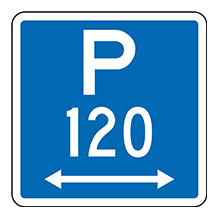
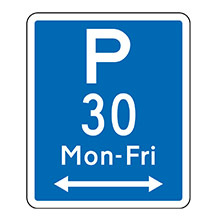
· Paid Parking
All machines accept New Zealand coins, and some of them have been introduced with credit cards and TXT-a-Park payment methods. Currently, you still need to go for Pay-and-Display parking. However, all machines will be upgraded by March 2018 to include Pay By Plate technology, which allows you to enter your vehicle’s registration plate number directly on the machine and pay for it by credit card, debit card, coins or TXT-a-Park. Note that there is a 50-cent fee for credit card or TXT-a-Park transaction.
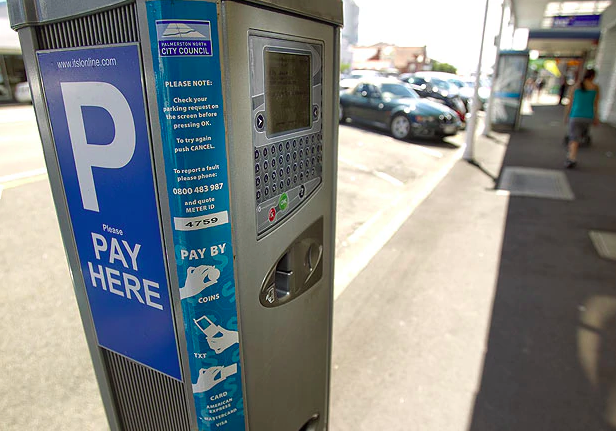 (Image from Stuff.co.nz)
(Image from Stuff.co.nz) Fuel Prices
Fuel PricesThe average gasoline price in New Zealand in November 2017 is $2.22 per litre, while it is of $1.47 for diesel.
 Toll
TollThere are three toll roads in New Zealand: the Northern Gateway Toll Road north in Auckland, the Tauranga Eastern Link Toll Road and the Takitimu Drive Toll Road in Tauranga.
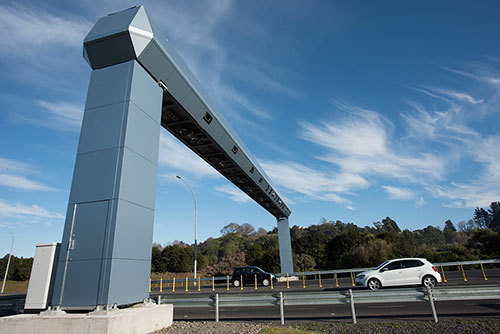 (Image from nzta.govt.nz)
(Image from nzta.govt.nz)How much you should pay depends on your car type. You can pay the tolls by debit or credit cards, POLi, and cash.
Debit or credit card
You can use your Visa or Mastercard to buy or pay a Pay & Go toll.
POLi
If you have Internet banking with ANZ, ASB, BNZ, Kiwibank, TSB Bank, Westpac or Bank Direct, then you can buy or pay a Pay & Go toll (external link) using Payment Online (POLi).
Note: POLi is not available for business internet banking customers.
Cash
If you prefer to pay with cash (or by debit/credit card) you can pay your tolls at selected service stations (a transaction fee of $1.20 per transaction will apply).
Be aware that as a car renter, not paying for the toll fee will result in the car hire company paying it for you and collecting the toll fee along with an add-on of management fee (note that it can sometimes be costly) from your credit card.
Traffic Violation
 DUI Laws
DUI LawsIf you are 20 or over, you must not drive if you have consumed more than the legal alcohol limit, which is 250 micrograms per litre of breath or 50 milligrams per 100 millilitres of blood (0.05%). There is a zero tolerance for alcohol if you are under 20.
 Traffic Fines
Traffic FinesIn New Zealand, exceeding the speed limit results in an infringement fine range from $30 to $630. The amount of the infringement fine will depend on the difference between the actual and legal speed limit.
As for parking, an infringement notice can be issued if a vehicle is parked illegally on public land, or in breach of what a parking sign says. In some circumstances, the vehicle can also be towed away if it is obstructing traffic.
Normally, there will be a website or hotline number on the front or back of the ticket as well as the reason for the violation fine and the relevant voucher number. Please be aware that you can log onto the website or call the hotline and follow the guidelines to pay the ticket.
Failure to pay tickets will result in the car hire company paying them on the renter’s behalf, and debit the renter credit card for the fine amount plus an administration fee. Please note that you can always contact QEEQ’ 24/7 customer service team for help if you have questions concerning this matter.
Driving Licence and Age Requirements
At the time of rental in New Zealand, all drivers must present a full and valid driving licence from the renters country of residence and the licence should be held for at least 1 or 2 years ( policies may vary depending on car hire companies). An International Driving Permit is highly recommended for international drivers. If your domestic driving licence is not printed in English (Arabic, Japanese, Cyrillic etc), an International Driving Permit (IDP/IDL) or an official translation in English is required when you drive in New Zealand.
Minimum age in New Zealand is 21 years (age may vary depending on car category) and the maximum is 80 years of age. If you're 21-25, you are likely to have to pay a young driver fee. If you're 65 or older, you may have to pay a senior driver fee.
Leer más detalles
Las mejores ofertas de alquiler de autos en Nueva Zelanda
Preguntas frecuentes
- Q1.¿Qué es un exceso de seguro?El exceso es la cantidad de la que solo será responsable en caso de daños (bajo Cobertura por colisión) o robo (bajo Cobertura por robo) del auto.
La información sobre el exceso se indicará claramente en la inclusión de precios cuando reserve un automóvil en QEEQ. - Q2. ¿Cómo puedo agregar un conductor adicional?Se recomienda realizar una solicitud al llegar al mostrador del alquiler. Un cargo adicional por día podría incurrir a menos que "1 conductor adicional incluido" esté estipulado en la reservación.
Por favor tenga en cuenta que los mismos requerimientos para la licencia y edad aplican para el conductor adicional. El conductor adicional debe presentar la licencia requerida junto con el conductor principal a la hora de la recogida. - P3.¿Qué pasa si quiero hacer la recogida o devolución del automóvil de alquiler fuera del horario de oficina?QEEQ le mostrará las ofertas de automóviles disponibles por el tiempo que seleccionó en la barra de búsqueda.
Sin embargo, la recogida o devolución fuera de los horarios de operación del proveedor podría tener como consecuencia un cargo extra a menos que se cuente con la opción de recogida o devolución de autoservicio.
Después de reservar un automóvil en QEEQ, le informaremos por correo electrónico de la política específica de la compañía de alquiler de automóviles. - Q4. ¿Puedo ir a otro país o cruzar la frontera con el auto que alquilé?Si desea hacer la recogida de su automóvil en un país y devolverlo en otro, los resultados de su búsqueda le mostrarán los automóviles con los que puede hacerlo.
Si planea cruzar cualquier frontera durante su viaje, tenga en cuenta que:
1. Es posible que tenga que pagar más.
A menudo hay cuotas adicionales, impuestos o cobertura adicional que pagará en el mostrador del alquiler de autos.
2.Podría estar prohibido el cruce.
Dependiendo de dónde alquile, es posible que no pueda llevar su automóvil a otro país.
Envíenos un correo electrónico si desea llevar su auto de alquiler a un país diferente durante su viaje, y hablaremos con usted sobre sus opciones. - P5.- ¿Puedo hacer la recogida de un automóvil en un lugar y devolverlo en otro?Sí. Puede hacer la recogida del automóvil en un lugar y devolverlo en otro. Se incurrirá en una cuota de lugar de devolución distinto al de recogida. Ya sea que esta cuota esté incluida en el precio de alquiler o que un costo adicional surja se le indicará claramente al momento de reservar con QEEQ.
Cuando haga la recogida del auto por favor informe de su lugar de devolución directamente a la compañía de alquiler de automóviles o comuníquese con ellos durante su viaje. Encontrará su número de teléfono en el contrato de alquiler que firmó al hacer la recogida del auto.
¿Tiene alguna pregunta? Simplemente visite nuestra página de ayuda .
Explore más destinos en Nueva Zelanda
Our Advantages
Suscríbete para ofertas y promociones exclusivas
Por favor, introduce una dirección de correo electrónico válida


 No U-turn
No U-turn







 (Image from nzta.govt.nz)
(Image from nzta.govt.nz)

